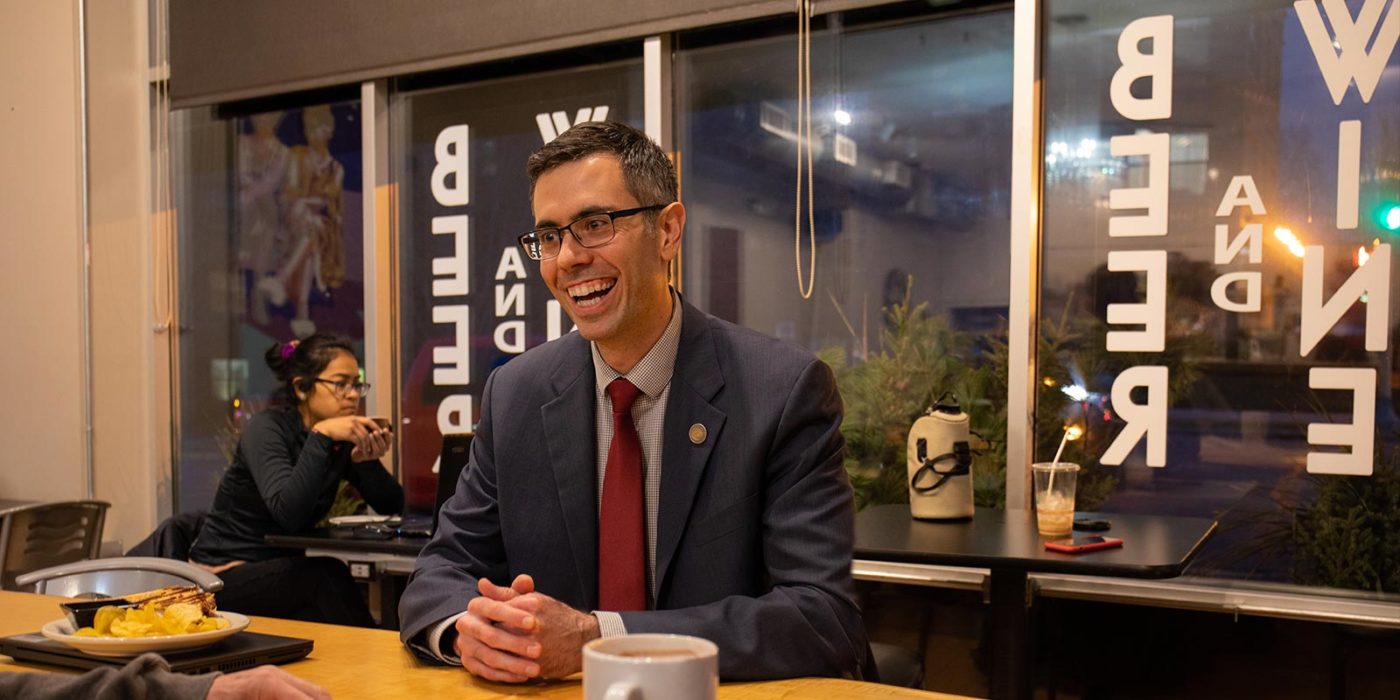Minneapolis Ward 12 City Council Candidate’s Stances on Transit, Biking, Walking, and Rolling
Pictured: Andrew Johnson
Move Minnesota and Our Streets Minneapolis have teamed up on a questionnaire for 2021 Minneapolis city council candidates to learn about their ideas and vision for the future of transportation in Minneapolis.
Access to quality transit, biking, walking, and rolling play an essential role in tackling climate change and ensuring equitable access to the opportunities and services the people of Minneapolis need to live healthy and fulfilling lives.
This questionnaire is for candidate and voter information only. Participating organizations will not be making endorsements in any Minneapolis city elections in 2021. This questionnaire was sent to all candidates, but those not listed have chosen not to respond.
Only one candidate from this ward has responded to the questionnaire.
The Responses
Question 1
What is your primary mode of transportation? How often do you ride transit?
Andrew Johnson:
Walk/Car/Bus/Other Public Transit
Question 2
Rethinking I-94 & Environmental Justice: Climate change and pollution disproportionately affect Black, Indigenous, and People of Color. Children in North Minneapolis—particularly those closest to I-94 in the 55411 & 55412 zip codes are hospitalized at rates as high as 4x compared to children in other parts of Minneapolis. During the last Minneapolis freeway reconstruction project, the city withdrew municipal consent for the I-35W reconstruction until the Minnesota Department of Transportation and the Metropolitan Council redesigned I-35W with highway Bus Rapid Transit, resulting in the Orange Line I-35W. Currently, the Minnesota Department of Transportation is exploring reconstruction efforts for I-94 going North out of the city; what role, if any, do you see the city playing in rethinking our freeways and addressing environmental injustice and pollution from freeways? Are there specific transportation or transit efforts you would pursue to achieve this?
Andrew Johnson:
We must work with and listen to BIPOC communities impacted by pollution. That is why we passed the “Rethinking I-94” resolution. We will continue to push for BRT and improved walking/bicycling connections, among the other stated goals in the resolution.
Question 3
Minneapolis Transportation Action Plan: State and city studies show that we will need to reduce how much people drive (“vehicle miles traveled”) to reach established emissions-reduction goals. Transportation is the #1 source of climate change pollution in Minnesota. The Minneapolis Transportation Action Plan has highlighted changing “mode split” (the shifting of car trips to transit, biking, or walking) as a critical strategy in reaching and measuring VMT reduction and in achieving overall emission reduction goals. The city now has an ambitious “mode split goal” to shift 60% of car trips to biking, walking, and transit by 2030. Despite an increase in bike and pedestrian infrastructure investments, data from the previous decade shows that VMT numbers dropped only 2% between 2007-2016. What specific transit, biking, and walking policies and investments should the city make, if any, to achieve Transportation Action Plan mode split goals? What new or accelerated interventions, if any, do you see as appropriate for reaching VMT goals by 2050?
Andrew Johnson:
We must follow-through on our many policies that intersect and overlap this issue: TAP, Vision Zero, Complete Streets, and 2040. More vibrant commercial nodes that bring goods and services closer to residents will help greatly. More walkable/movable streets year-round will improve seasonal access. Safer infrastructure design will increase comfort and utilization. And of course, public transit improvements will benefit all residents.
Question 4
Bottineau/Blue Line Extension: This LRT project was deemed unworkable on its currently planned route on BNSF right-of-way. However, there is still substantial interest in a Bottineau project because transportation connects people to social activity, economic opportunity, educational institutions, healthy food, and critical health services. North Minneapolis has been historically underserved by transit compared to other parts of the city; however, there are also community concerns from North Minneapolis residents of displacement and gentrification surrounding the Blue Line extension project and transit-oriented development.
What policies or programs, if any, should the city implement to ensure the success of major transit investments for both current and future communities along the line?
Andrew Johnson:
Targeted investment in affordable housing, land trust programs, ownership programs, and stabilizing existing independent commercial businesses will all help reduce displacement while allowing for more individuals and families to live in proximity to transit options.
Question 5
Hennepin Avenue: The City of Minneapolis is currently considering several design options for the stretch of Hennepin Avenue that runs between Lake Street and Franklin Avenue. The currently proposed design options for Hennepin Avenue include bus lanes, two-way traffic, and loading and parking zones; one option includes bike infrastructure, and the other design includes street greening.
On streets like Hennepin Avenue—which are key commercial corridors, have dense housing nearby, and have limited space to work with—what approach, if any, should the city take in balancing current and long-term needs for our transportation networks?
Andrew Johnson:
This is a 1.4 mile stretch of road, and the difference between option 1 and option 2 is 30 parking spaces. So about 3 spaces per block on average. Option 1 has a protected bikeway that will serve hundreds of riders daily and likely save lives and prevent countless more serious injuries over the decades to come. The choice between 3 additional parking spaces per block on average or hundreds of transit users and their physical safety seems clear. I support option 1.
Question 6
Bus Priority: Transit operations cross multiple jurisdictions of government. Metro Transit manages bus operations and service schedules. The city of Minneapolis and Hennepin County have authority over most of the streets Metro Transit Buses run through; and, the city also has control of the stoplights within city limits.
What improvements, if any, should the city be pursuing to improve speed and reliability for Minneapolis transit riders? How do you see the city, Metro Transit, and Hennepin County collaborating to improve bus service?
Andrew Johnson:
I have fought to expand BRT through additional funding/investments. Additionally, I support implementing signal priority and expanding dedicated transit lanes. We will continue to work with our other jurisdictional partners on implementing these improvements.
Question 7
Parking Policy: The City of Minneapolis recently eliminated parking minimums; however, the city approved both a multi-thousand Allina parking ramp and proposed a parking plan for the Roof Depot site with spots for nearly every employee or visitor to travel by car, which is not in alignment with the city’s mode shift goals as cited in the TAP.
What role do you think the city should play, if any, in reducing parking to meet mode shift goals?
Andrew Johnson:
The City itself should not be building additional ramps that are costing upwards of $50,000 per space. On the private side, removing minimums and requiring more intentionality for other modes was the right move. That said, I do not believe we should prevent private parties from building additional parking on their land if it is designed in a way that does not negatively impact the streetscape.
Question 8
Traffic Enforcement: A recent article in the Star Tribune found that 78% of police searches that started as stops for moving or equipment violations from June 2019 through May 2020 were of Black or East African drivers. Also, in 2016, Our Streets Minneapolis published a report that suggests black bicyclists face greater threats of police violence than white bicyclists, especially for small infractions like failure to use a light or riding on the sidewalk.
What role should the city play, if any, in changing or maintaining how minor traffic violations are enforced? or maintaining how minor traffic violations are enforced?
Andrew Johnson:
I authored an amendment to our legislative agenda to pursue legalization of automated enforcement for vehicles. Automated enforcement, coupled with a public education campaign, would prove much more effective and safer to improve driver behavior. I support this approach rather than armed officers when it comes to minor traffic infractions.
Question 9
Snow Removal: Sidewalks that are inadequately shoveled create both risks and barriers for pedestrians and transit riders. We also know that the risks and barriers aren’t experienced equally– with Minneapolis senior citizens and community members with disabilities being the most impacted by neglected sidewalks in the wintertime.
What changes, if any, would you advocate for in how our city addresses snow and ice removal from sidewalks during winter?
Andrew Johnson:
I have been leading efforts to improve sidewalk snow and ice clearance in our city. This includes more education, ramping up proactive enforcement, and stronger support systems for those physically or financially unable to clear their snow. I also led efforts to get a study on full municipal clearing. Additionally, I support increased city-clearing of corners and priority corridors.
Question 10
Bike, Walk, Roll: What actions, if any, will you take to make Minneapolis better for biking, walking, and rolling by the end of your term, if you are elected?
Andrew Johnson:
My efforts have included changes to policy to improve ADA pedestrian ramp upgrades, and proactively working to remove obstacles in the right of way to improve safe clearance. There have been several infrastructure improvements I have helped make throughout our ward and city when it comes to street design and have also helped move a segment of the grand rounds under a bridge to reduce pedestrian-vehicle conflicts. I will build on these efforts and continue finding new opportunities. One of the things I am seeking to do is improve crossings along Hiawatha Ave, which is a big barrier for our neighborhoods.
Thank you to the candidates for their responses to the questionnaire.
Early voting is already underway in Minnesota. For more information on how to check your voter registration, absentee voting, and early voting please visit the Minnesota Secretary of State’s website.
Be a Voter
Election Day is coming up! If you want your elected officials to reflect your values, pledge to vote on or before November 2.

